Category: Beginner Waistcoat
Fitting and Alterations
A waistcoat, with only a few seams, is one of the easiest garments to fit. After you have constructed your toile, try it on, and look for any excess fabric, or pulling. This will help you decide on the adjustments to be made on the pattern.
At the waist, is the waistcoat loose or tight? Try to determine by how much, either by measuring or rock of eye (estimating). Any alterations at the waist can be added at the back side seam and the center front. Since waistcoats from the 1860s almost always had a belt in the back for adjustment, I usually make the side seam in the back vertical, just to give some extra room to grow into.
Then examine the back neck for the balance. Once you’ve learned this you’ll be staring at the back of other people’s coats to see how their balance is. If the balance is too long, you’ll see horizontal folds just under the collar or neck area. And if the balance is too short the back of the vest will pull way from the neck – you see this often if someone has a stooped posture.

As everybody is different, it’d be impossible for me to go over every possible variation. So, if you’d like help with your fitting, please share in the support community a photo of your pattern from the top down, as well as photos of you wearing the waistcoat from the front, sides, and back, and I’ll help you with the alterations as best I can.
Muslin Toile
With the pattern cut out you can cut out your cotton muslin to make a toile for fitting purposes. Please refer to the video for more detailed construction.
First, cut out your fabric with the center back placed on the fold, following the grain alignment marks for both front and back. Any darts are simply marked but are not cut out. Mark an ‘X’ on the wrong side of each piece to help keep everything in order.
Next, if you’re using any darts, it’s time to close them up while the pieces are still separate and easier to deal with. Fold the dart in half lengthwise, right sides together, aligning the chalk marks on both sides as best you can.

Pin the dart closed.
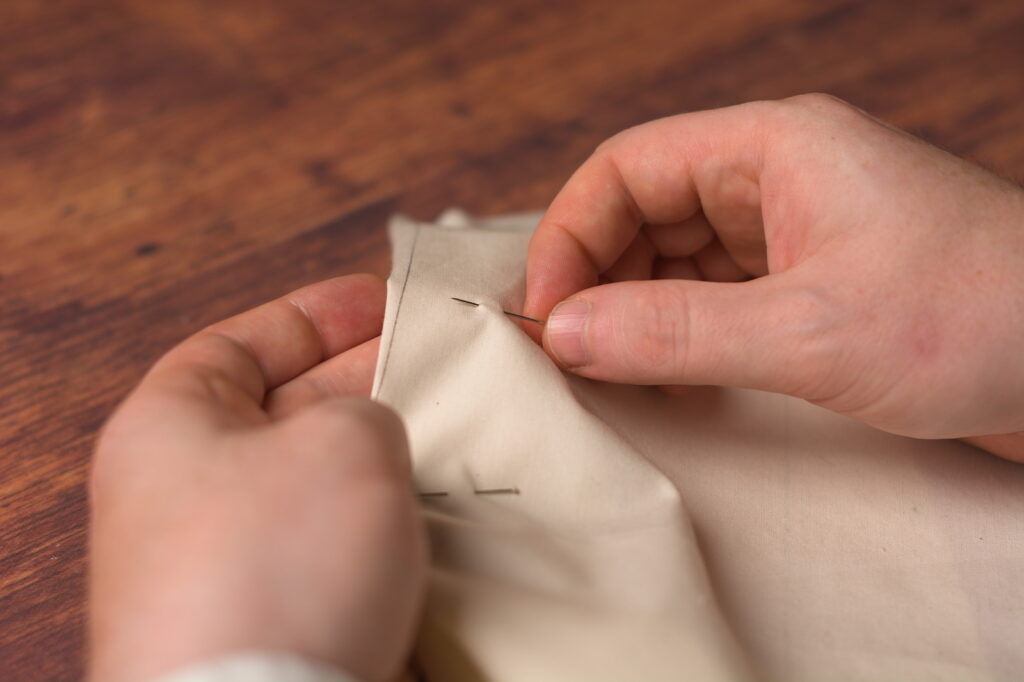

Sew the dart closed from the bottom of the dart towards the tip, opposite of what I did in the photo, for best results. Follow the outside of the chalk line as closely as you can.
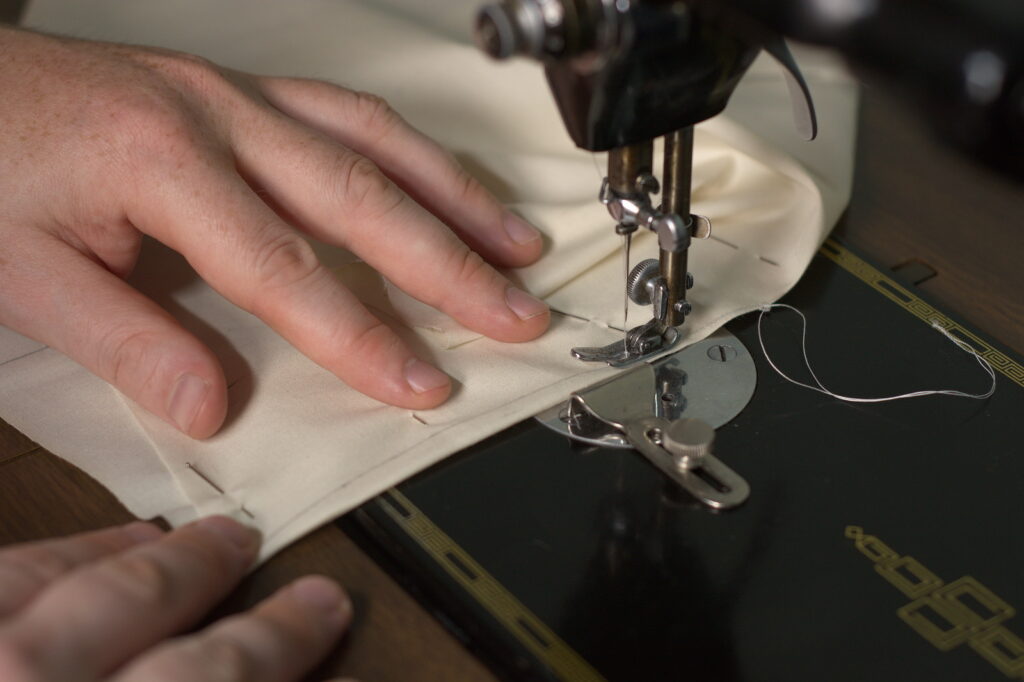
Press the dart to one side.
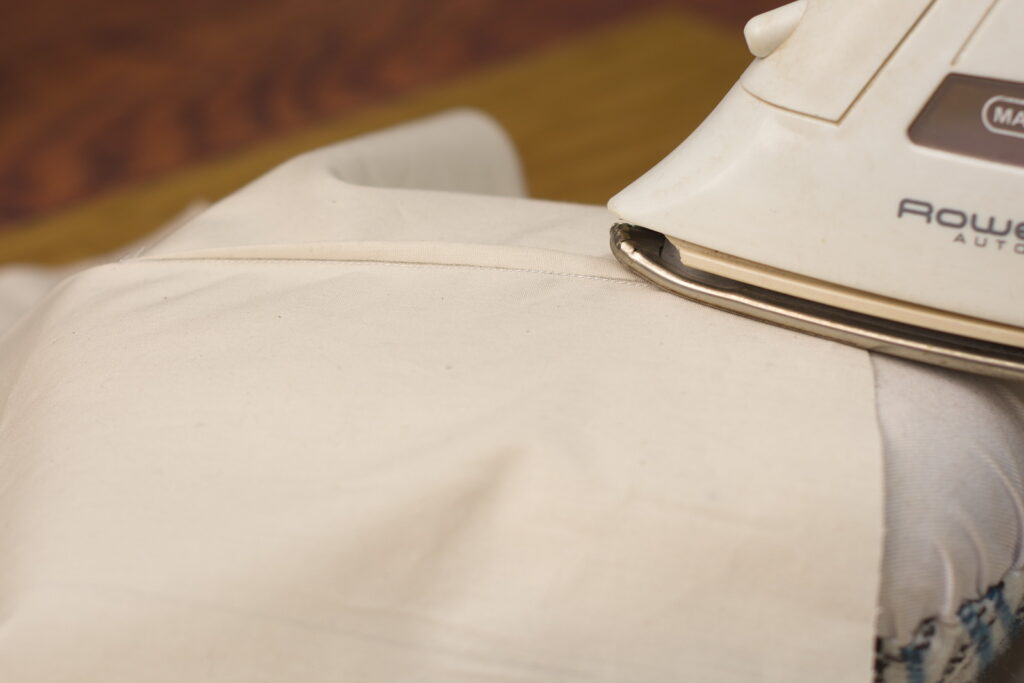
Pin the side seams together.
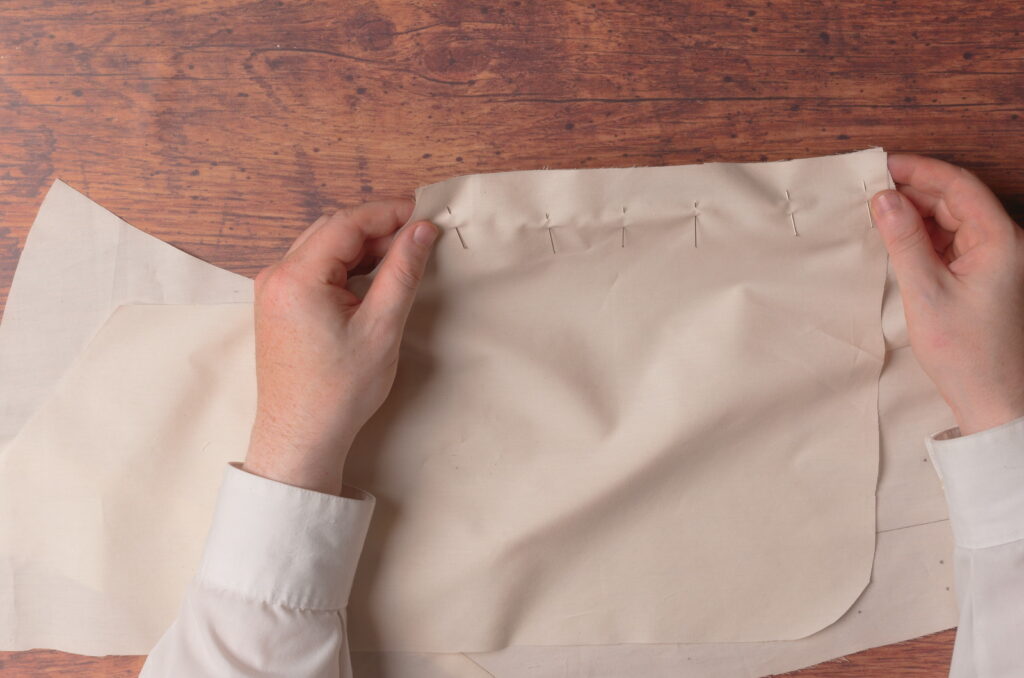
Also pin the shoulder seams, aligning the seam allowances carefully.
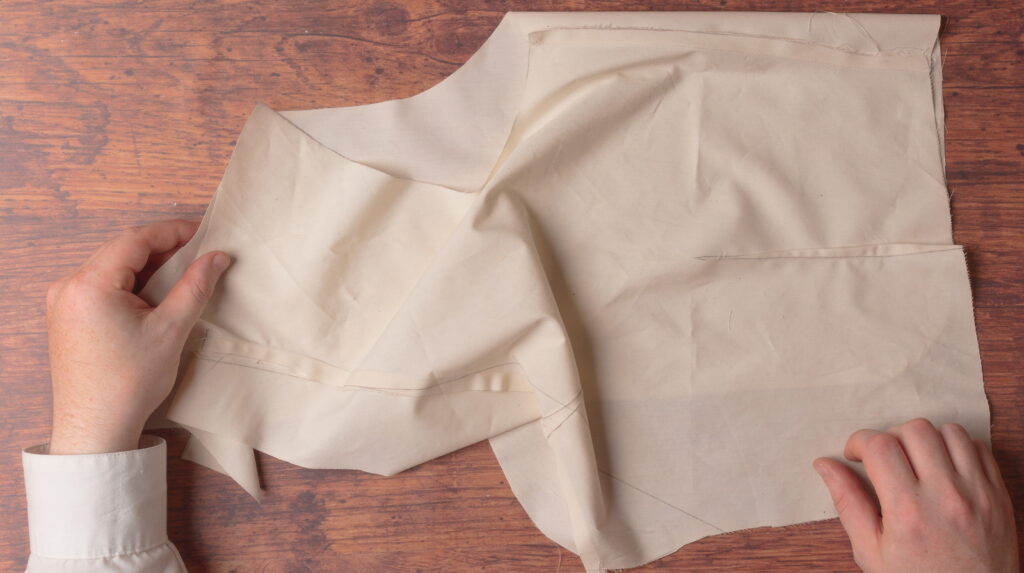
At both ends of the shoulder seam you’ll end up with a little overlap due to the angles of the neck and armscye. Just keep the 3/8″ seam allowance aligned.
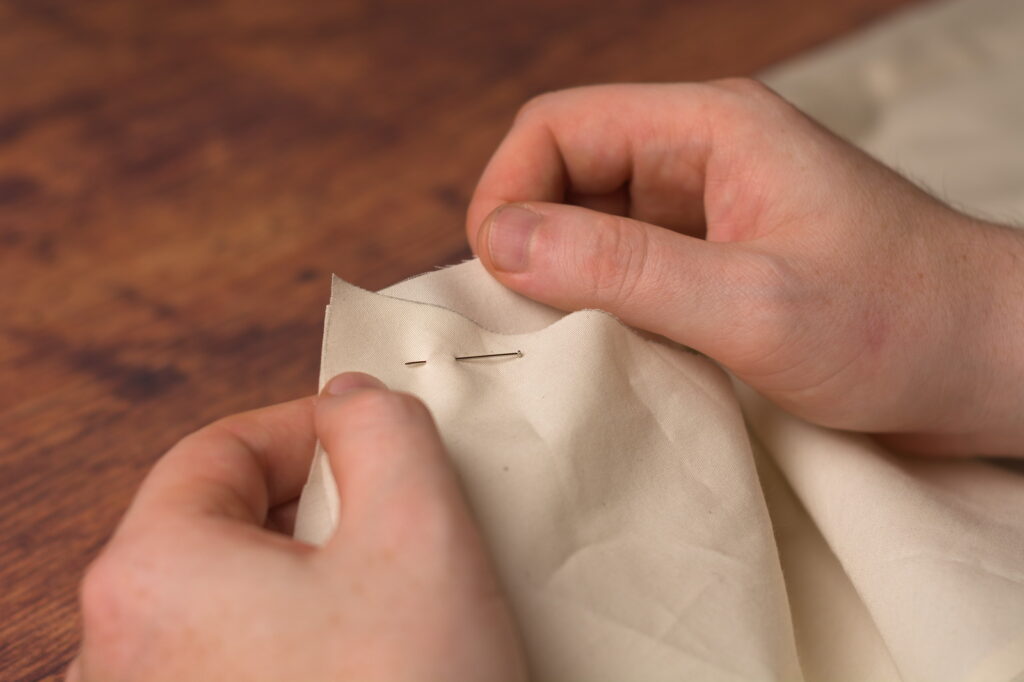
Sew the shoulder seams and side seams closed with a 3/8″ seam allowance.

Press open the shoulder and side seams. It’s helpful to use a tailor’s ham for the curve of the shoulder seam if you have one.
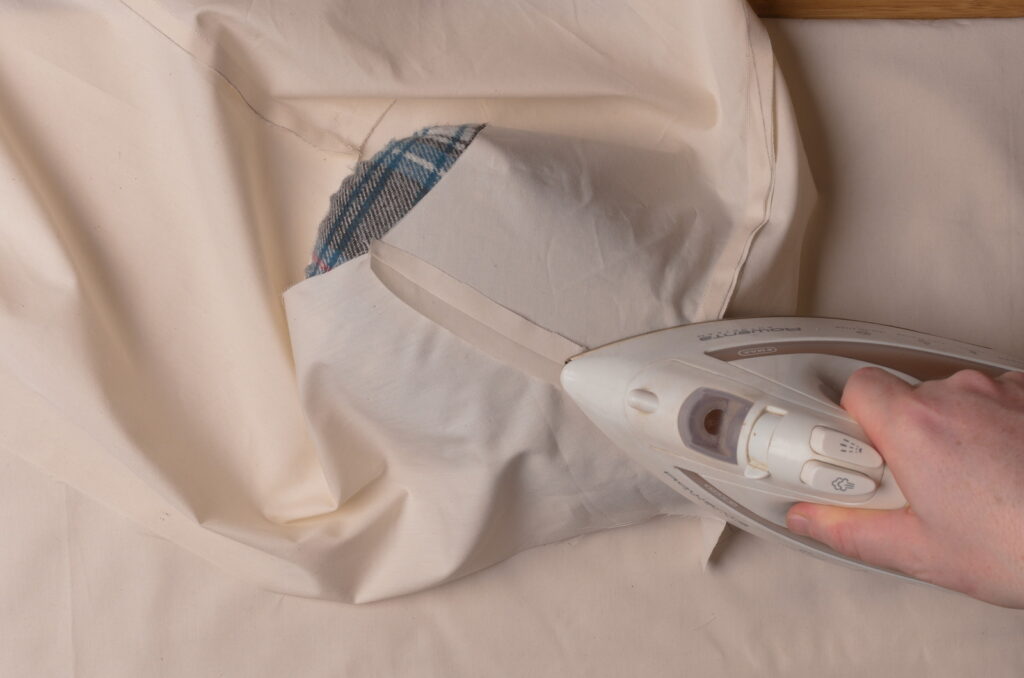
And that completes your waistcoat toile. Go try it on to see how it fits!
Checking your Measurements
Before cutting out your pattern (or after if you forget!), it’s a good idea to check your measurements one last time. Here I’ve got them all laid out for you in one diagram. Remember that you want to measure without including the seam allowances. Also, keep in mind that any pattern is just a start – it takes fitting to perfect the pattern, especially if you are a beginner, and don’t be afraid to start completely from scratch if necessary. The next pattern will be all the better. When you’re comfortable enough with your draft, you can go ahead and cut it out – be sure to keep the seam allowances!
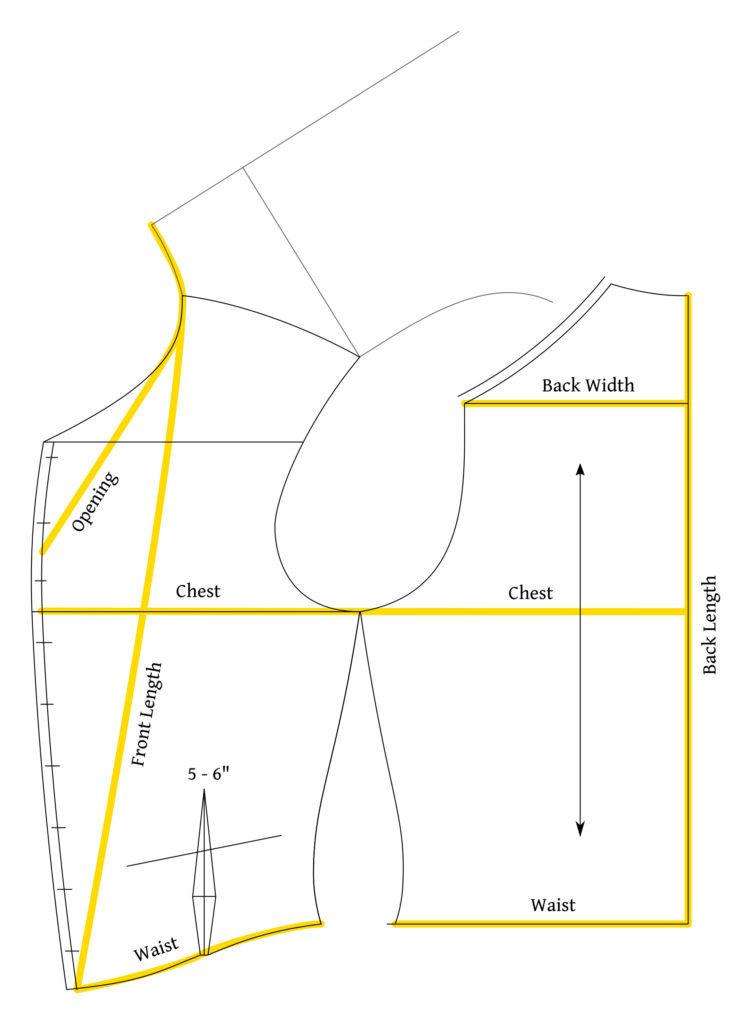
Darts
If you have a very athletic build, you may be able to add a dart to the front for additional waist suppression and more shape. These darts should only be added if your waist measurement is at least 6″ smaller than your chest measurement.
First, determine the position and length of your dart, usually at the middle of the front waist, and extending through the pocket vertically, about 5 – 6″ in length.
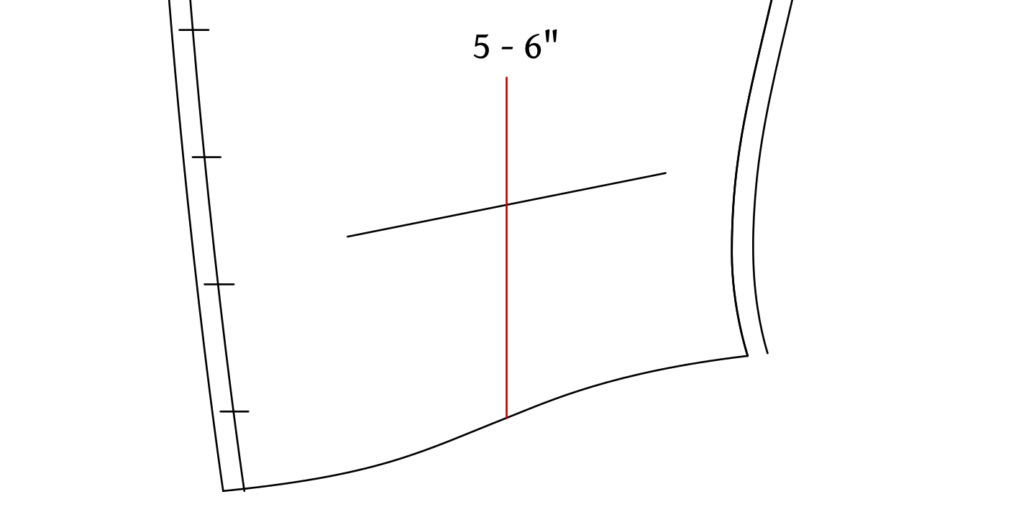
Next, about two inches from the bottom, or where the natural waist would be, determine the width of your dart. This is best done by checking the length of the waist across the two pieces, comparing it to your actual waist measurement, and taking out from between 1/2″ to 1″ total at this position in the dart. You’ll have to use your best judgement as to how much to take out in the darts, as compared to the side seams, but feel free to ask me for advice here.
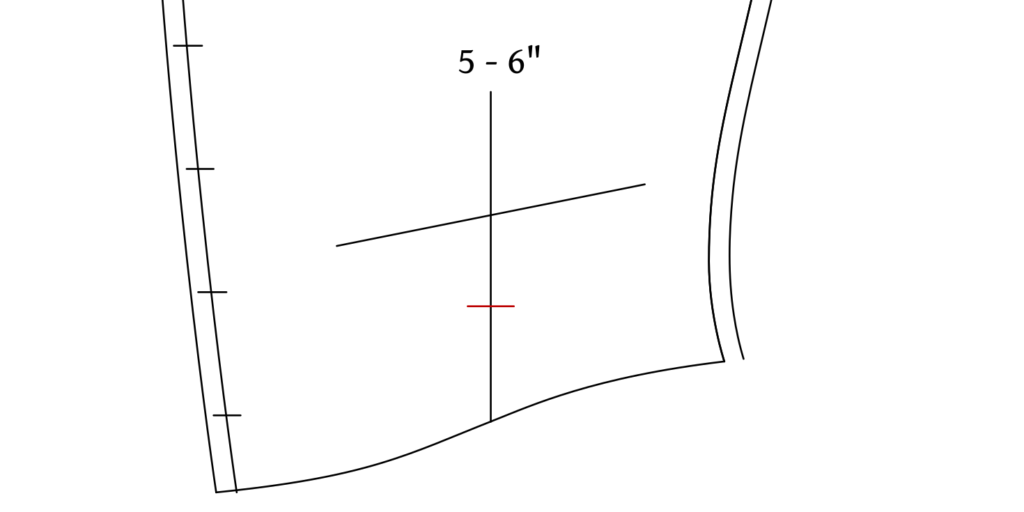
Now connect the points of the dart. I usually make the bottom about 1/4″ wide, or 1/8″ on either side of the construction line, but again that depends on how wide you’ve made the fullest part of the dart.
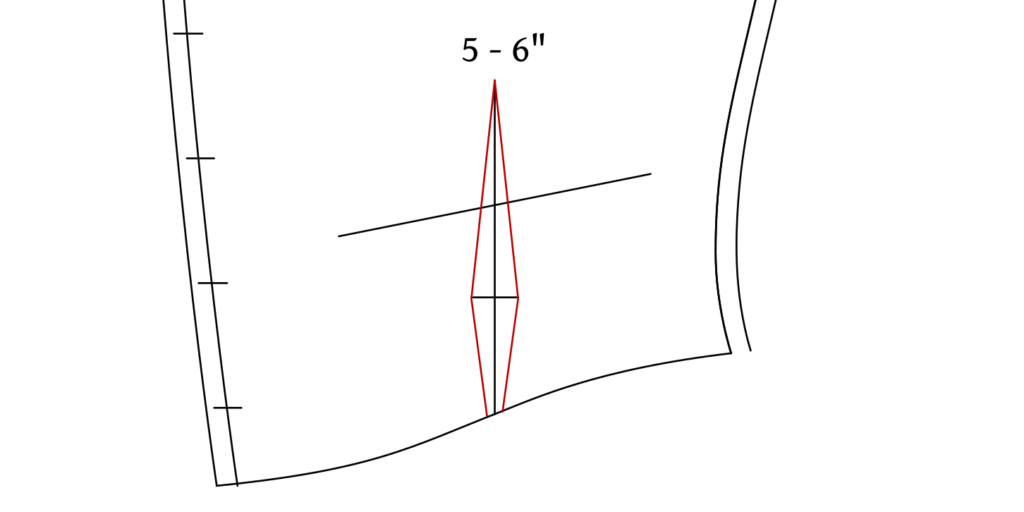
Finally, I like to lower the waist seam at the back edge of the darts, just to make the lengths equal. It helps a bit when making up the waistcoat, otherwise you end up with a jagged looking bottom edge before turning, and can run out of seam allowance if you’re not using an inlay.
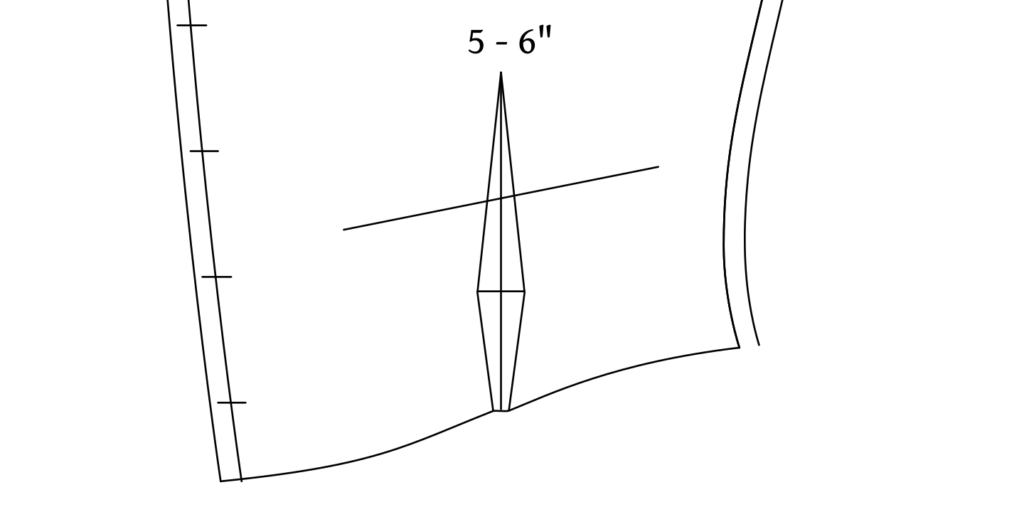
Adding Seam Allowances
With your draft done, you’ll need to add a few seam allowances to make sure it fits properly. Since this is only going to be a muslin toile for fitting purposes, I typically add seam allowances only at the shoulders and side seams. I’d recommend 3/8″ (actual inches) here, as it gives more room to work with than 1/4″ as well as prevents fraying, while at the same time not being quite as bulky as a full 1/2″.
Now, you do have a choice to make here. You could add the seam allowances directly to your pattern and cut everything out afterwards – this does break apart your original pattern however. Or you can copy the outlines and waist / chest lines to a fresh sheet of paper and add the seam allowances to that so as to preserve your original pattern for future use. It’s up to you and one way isn’t really more difficult than the other – it’s more how you prefer to work.
Use your quilting ruler to add the seam allowances to the shoulder seams and side seams.

Here’s a simplified view of the pattern so far after adding seam allowances at the shoulders and side seams. I’ve also added some vertical lines to indicate the grain of the cloth – just makes it easier to keep track of when cutting everything out.
Along the front edge I added the position of the buttons. These are 3/8″ (graduated or not) inches from the edge. The top button is about 1/2″ from the top, the lowest button is about an inch from the bottom. Then I just spaced the buttons evenly from top to bottom for a total of nine.
Finally, although it’s out of the scope of this course, I added a pocket along the bottom of the front just for reference. It’s about 5 graduated inches long, and roughly follows the waist construction line about 3 – 4″ above that.
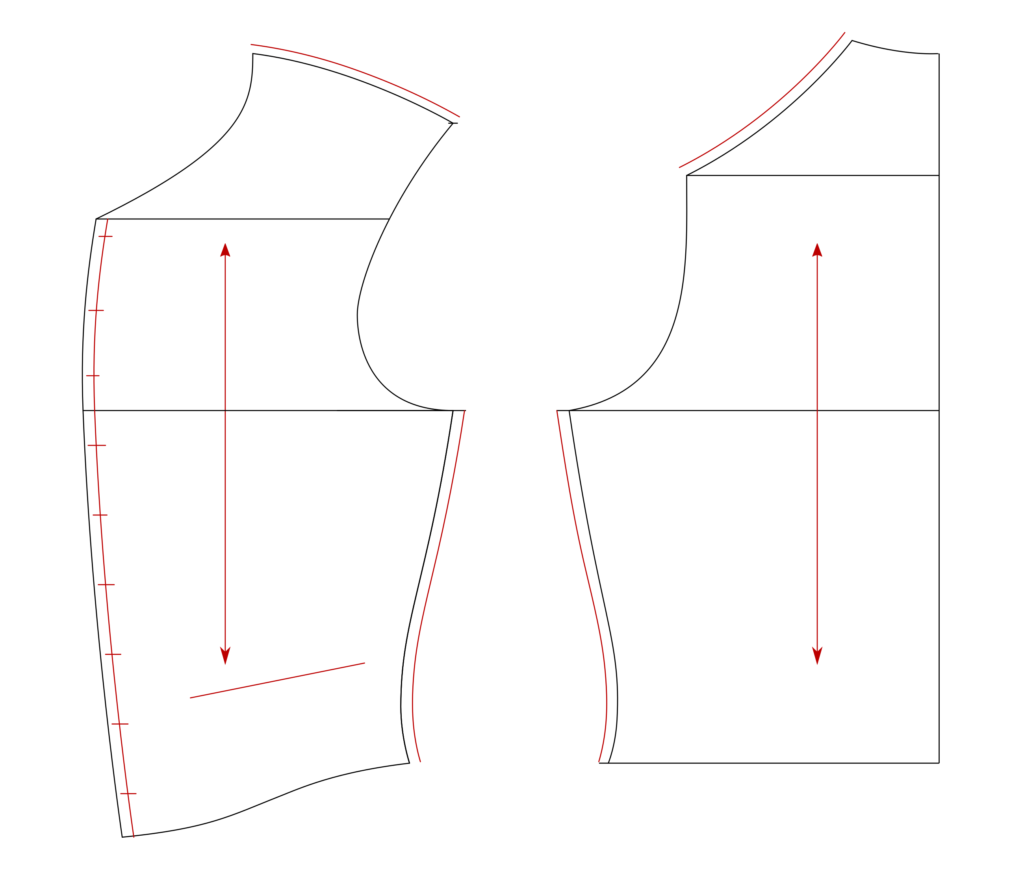
Drafting the Front
With the back completed, we can move on to drafting the front of the waistcoat, or forepart.
Begin by drawing another vertical line about 2 – 3 inches away from the back piece – just to give yourself room to work with. Mark the following points from 0 in graduated inches.
- Mark 0 at the top.
- 2
- 4 3/4
- 7 1/2
- 10 1/4
- 19 1/8
- 20 3/8
- 22 1/2
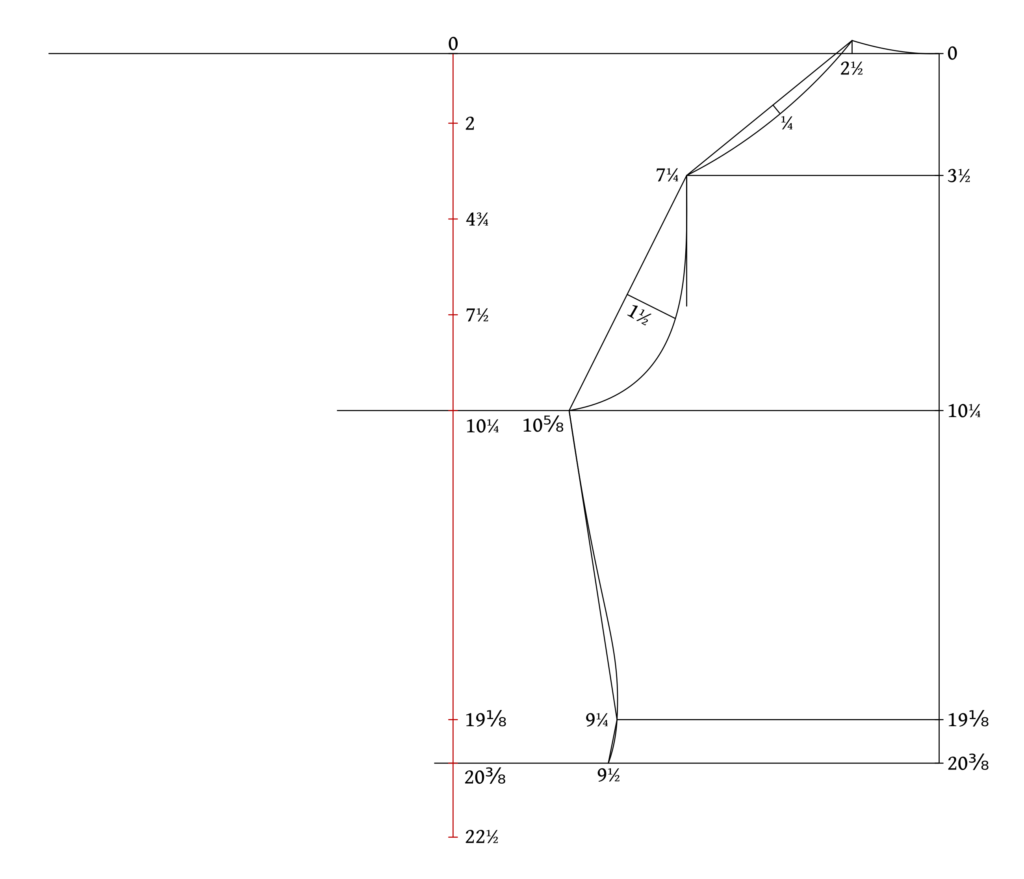
Square across from these points as before – some of the lines you may have already drawn if you extended them far enough from the back. Then measure out the following distances.
- 5 3/4 from 0
- 10 1/4 from 4 3/4
- 2 3/4 from 7 1/2
- 10 5/8 from 10 1/4
- 1 1/2 from 19 1/8
- 1 1/4 from 20 3/8
- 9 1/2 from 22 1/2
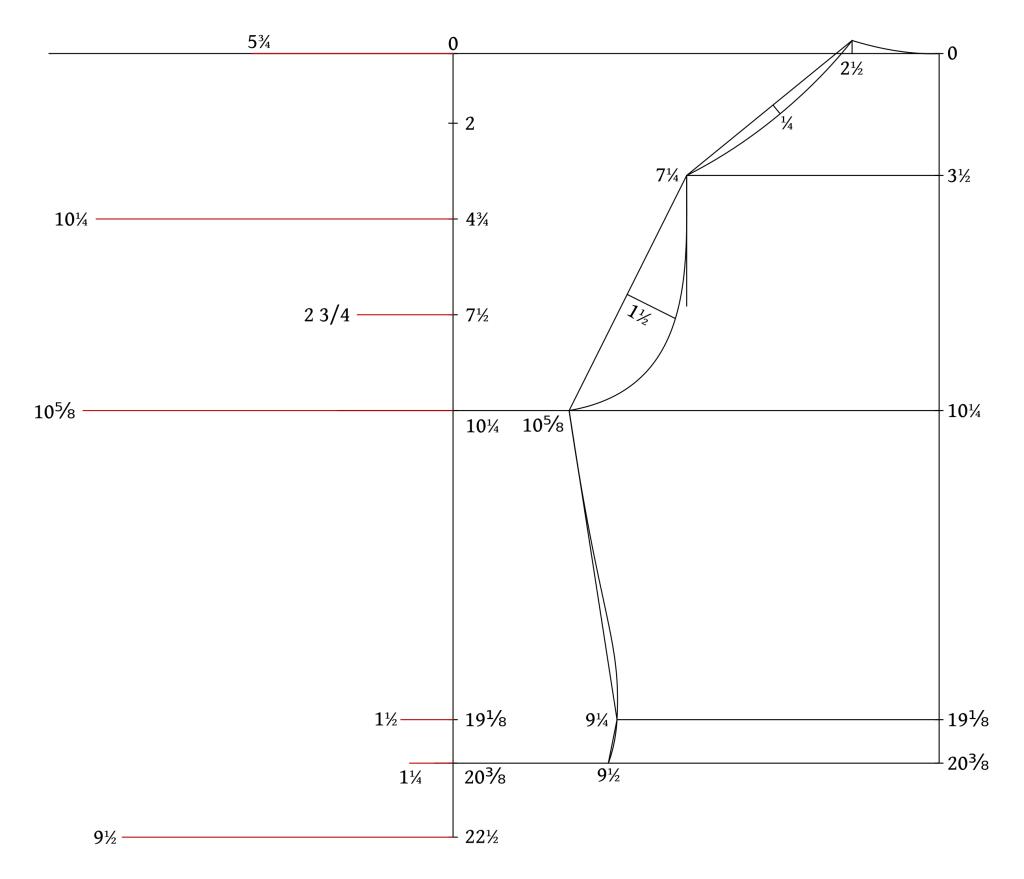
Draw in the construction lines connecting the following points to aid in drawing the curves.
- 5 3/4 to 2 for the shoulder.
- 2 to 2 3/4 for the front armscye.
- 2 3/4 to 10 1/4 for the bottom armscye.
- 10 1/4 through 1 1/2 to 1 1/4 for the side seam.
- 1 1/4 to 9 1/2 for the waist seam.
- 9 1/2 through 10 5/8 to 10 1/4 for the center front.
- 10 1/4 to 5 3/4 for the neck seam.
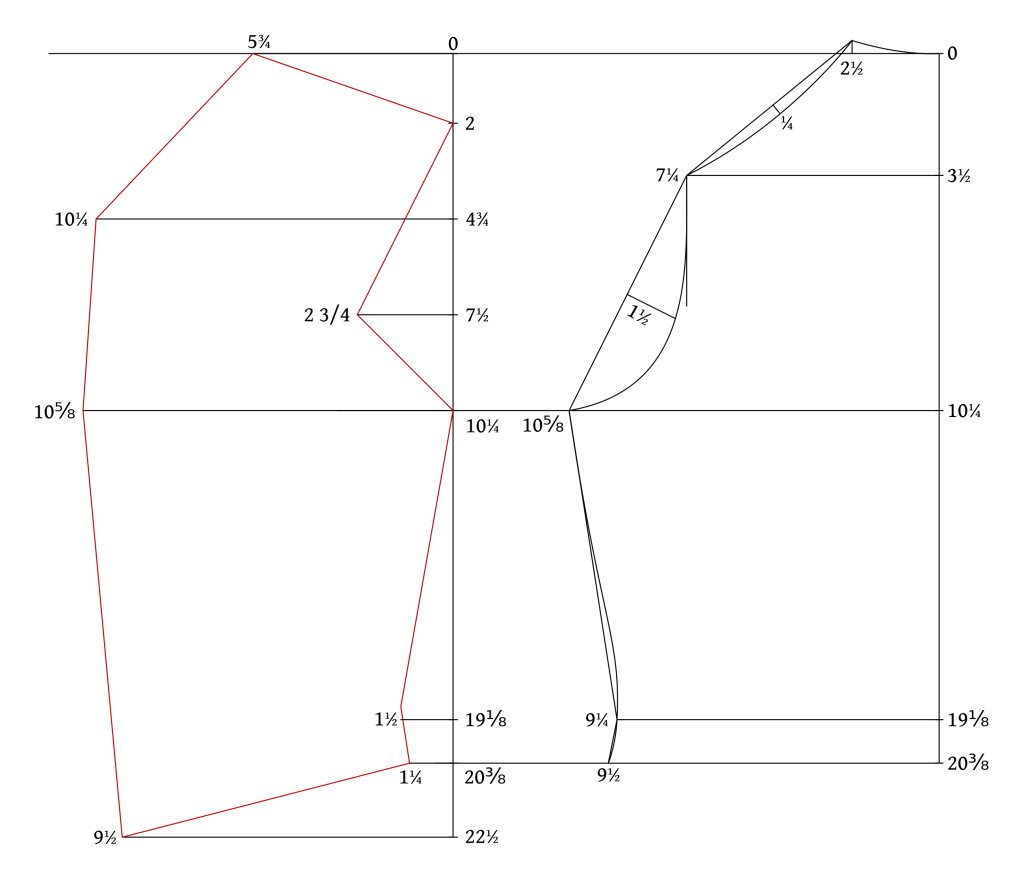
To find the depth of the curves:
- Measure 2 1/4 graduated inches from 5 3/4 along the neckline. Square in 1 inch for the curve of the neck.
- Find the center of 5 3/4 to 2. Square out 1/4 graduated inch.
- Find the center of 2 to 2 3/4. Square in 3/8 graduated inch.
- Find the center of 2 3/4 to 10 1/4. Square in 7/8 graduated inch.
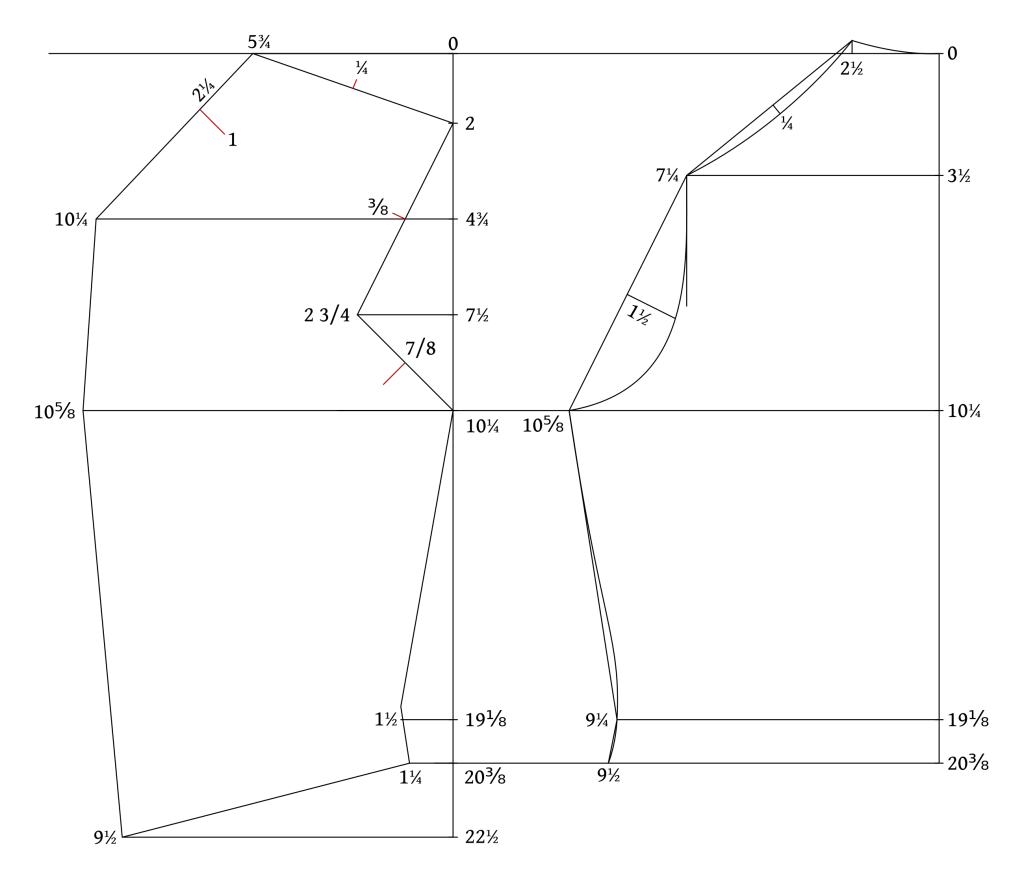
Finally, draw in the curves as shown:
- 5 3/4 to 2 forms the shoulder seam. Should be a shallow curve.
- 2 through 2 3/4 to 10 1/4 for the armscye. At 2 3/4, the curve should be close to vertical – that will help you with the shape of the curve.
- 10 1/4 through 1 1/2 to 1 1/4 for the side seam. This forms an ‘S’ curve very similar to the side seam of the back, just in the opposite direction.
- 9 1/2 to 1 1/4 for the waist seam. I like to first find the midpoint between the two. Then draw in a very shallow ‘S’ curve as shown. It should almost form a right angle with the center front.
- 9 1/2 through 10 5/8 to 10 1/4 for the center front.
- 10 1/4 through 1 to 5 3/4 for the neck seam. The curve starts out very shallow at 10 1/4 and deepens after 1. The curve should be just about vertical as it heads into 5 3/4.
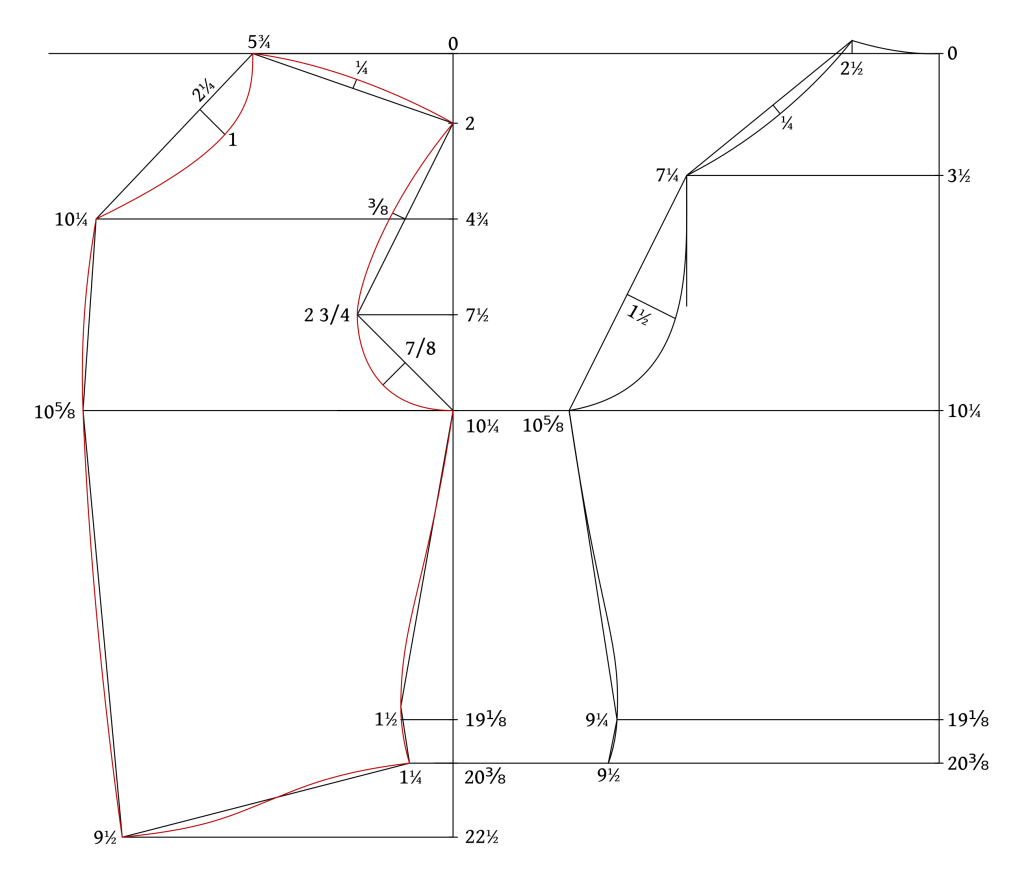
This completes the draft itself. Next we’ll add seam allowances and double check the measurements one last time.
Drafting the Back
Before drafting, lay out your paper on the table. You’ll want to have a big enough piece to be able to fit the entire draft.
The draft is started by drafting a vertical line along the left edge – this will become the center back. Mark 0 at the top and then using the graduated measure corresponding to your chest measurement, lay out the following points, measuring from 0.
- 3 1/2
- 10 1/4
- 19 1/8
- 20 3/8
You can measure from 0 to 20 3/8 and compare that to your back length measurement. As long as it’s within an inch or two, I’d go with what the pattern says. If it’s off by more than that, you may run into issues – let me know your measurements and how far you’re off and I may be able to see what’s going on.
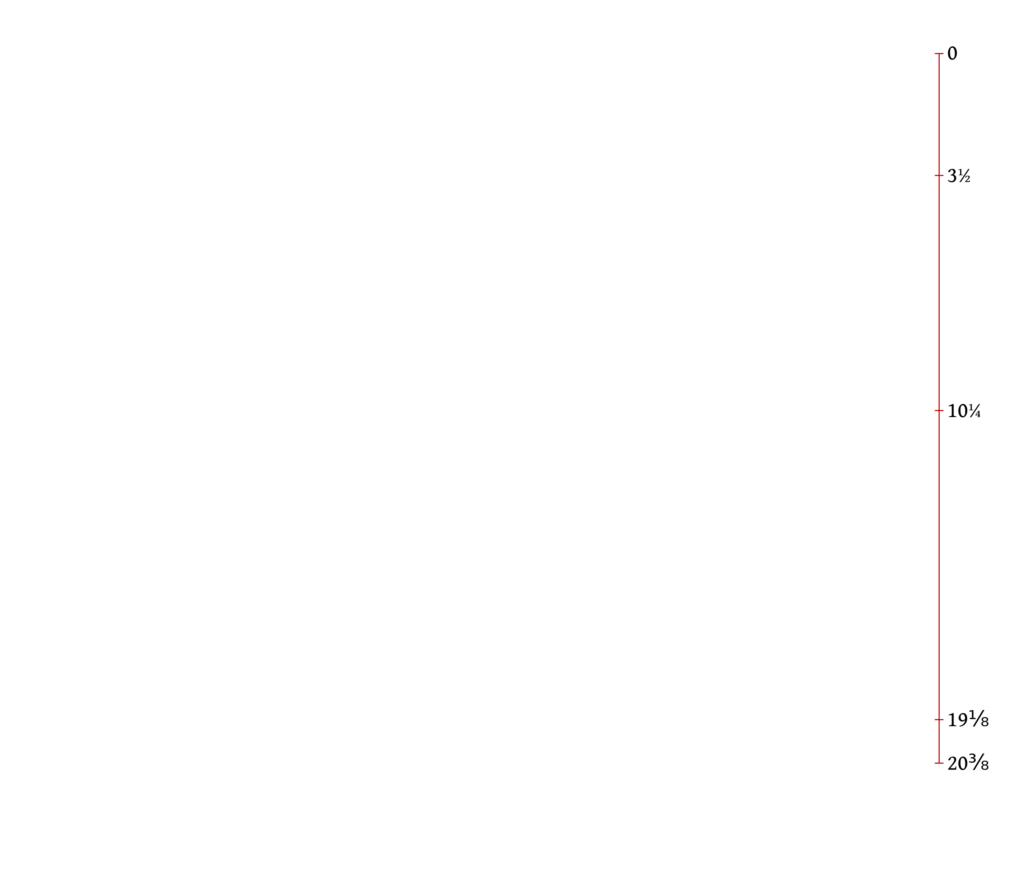
Now square out, or draw a line at a 90 degree angle, from each of those points you just measured out. From 0 and a few of the other points, feel free to extend the lines further as shown (the length doesn’t matter yet) so you can use the same lines for the forepart.
From each of the squared out lines, measure in graduated inches the following lengths. I usually just make a little mark at each of the distances.
- 2 1/2 from 0
- 7 1/4 from 3 1/2
- 10 5/8 from 10 1/4
- 9 1/4 from 19 1/8
- 9 1/2 from 20 3/8
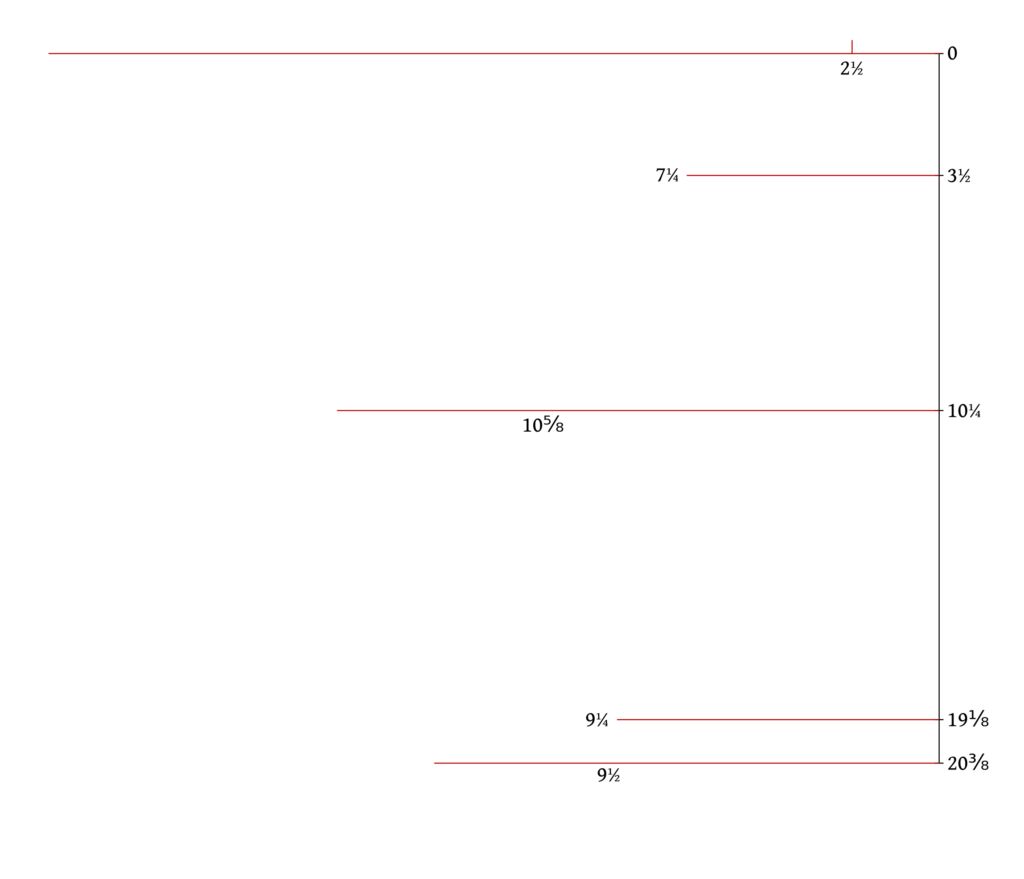
Now connect the points you just drew with construction lines as follows. These lines help to determine the curves in the next step.
- at 2 1/2, square a line upwards 3/8 graduated inches for the neck curve.
- Connect 2 1/2 to 7 1/4 for the shoulder.
- At 7 1/4, square down a line to about halfway towards the next line.
- Connect 7 1/4 to 10 5/8 for the armscye.
- Connect 10 5/8 to 9 1/4 to 9 1/2 for the side seam.
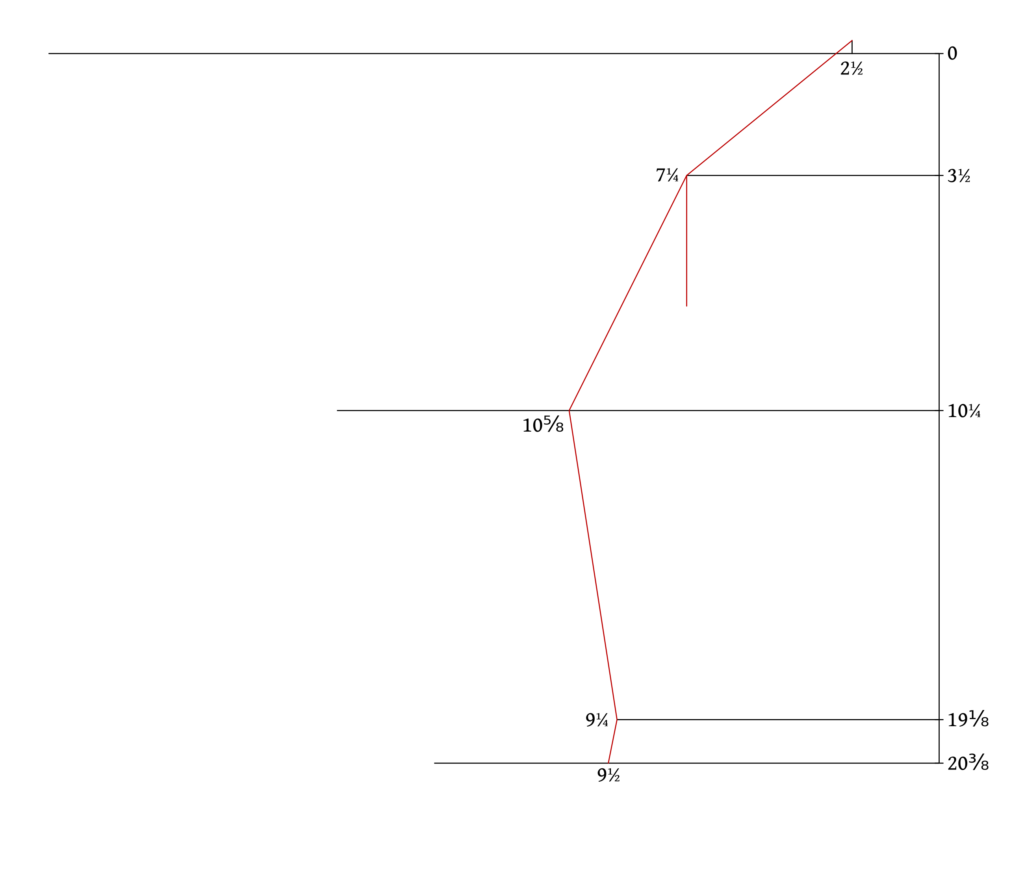
Next up, we need to add two small construction lines to find the depth of the curves.
- Find the center of line 7 1/4 to 2 1/4 (remember you raised that 3/8). Square in 1/4 graduated inch.
- Find the center of line 10 5/8 to 7 1/4. Square in 1 1/2 graduated inches.
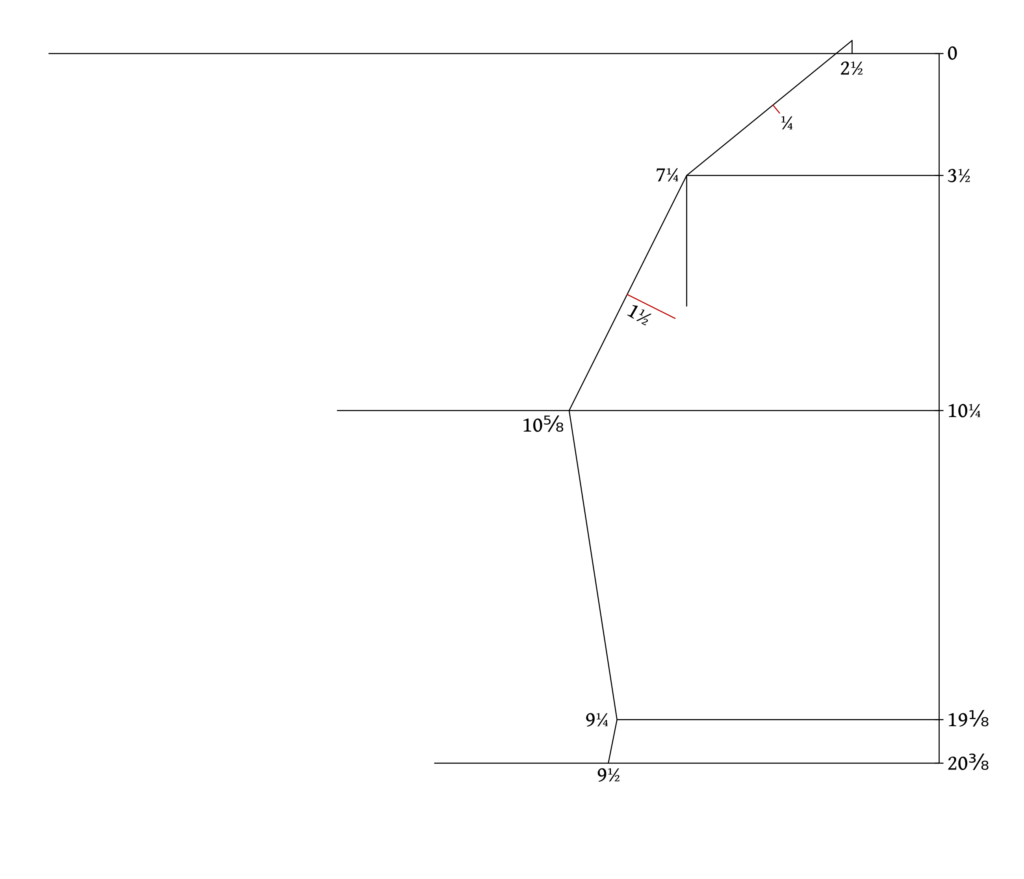
Finally, draw in the curves as shown using your preferred method – a French curve, bendable drafting ruler, or free hand.
- Draw in the neck curve from 2 1/2 to 0.
- Draw the shoulder seam from 7 1/4 through 1/4 to 2 1/2 with a shallow curve.
- Draw the armscye from 10 5/8, rather deeply through 1 1/2, becoming vertical as it meets the vertical construction line.
- Draw the side seam from 10 5/8, beginning about halfway down, curving through 9 1/4 to 9 1/2. It forms a sort of very shallow ‘S’ curve.
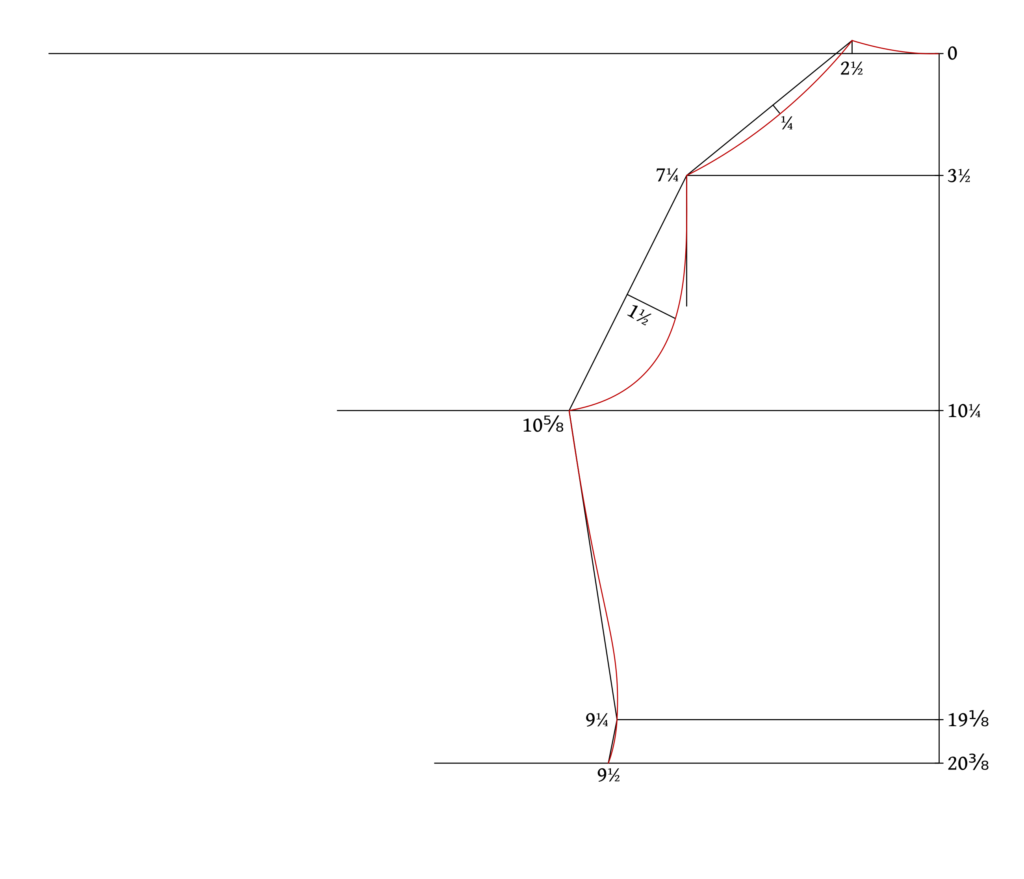
And that completes the draft for the back piece. You can compare the draft to your actual measurements as follows to make sure you’re on the right track.
- 3 1/2 to 7 1/4 should be approximate to half of your back width measurement.
- 10 1/4 to 10 5/8 should be about half of your chest measurement.
- 0 to 20 3/8 should be close to your back length measurement.
- 20 3/8 to 9 1/2 should be half your waist measurement.
If somethings within an inch or two I’d leave it and continue on to see what happens. If there’s a larger discrepancy, please share your measurements and a photo of your pattern in the community and I’ll have a closer look at it for you.
Taking Measurements
The basis of any good pattern depends upon first taking good and accurate measurements. This definitely takes some practice though, so just get as close as you can. And before you take measurements, it’s a good idea to examine the posture and shape of the person your measuring (if it’s yourself, use a camera or mirror if necessary). Does the person stand erect or have a hunch to the back (very common with our phones these days). Or are they thin or more corpulent? With practice you can tell if a pattern looks ‘off’ when compared to what you’ve seen with the posture, saving yourself from making mistakes and having to do an extra fitting.
There are six general measurements I take to get the basic waistcoat pattern. I generally take these over a dress shirt or a period shirt if you have one. You can also take them over another waistcoat and that will give you a slightly more relaxed fit.
Downloads
- Waistcoat Measurements (Libre Office)
- Waiscoat Measurements (Microsoft Office
- Waistcoat Measurements (PDF)

Chest
Hold the tape around the chest as shown, as high as possible under the arms, and over the fullest part of the chest, holding the tape with the thumb and forefinger of each hand. Draw the tape snug but not tight, and loosen it gently as the client breathes, for the best accuracy. This measurement determines the size of the graduated measure you should use.
Waist
Measure around the natural waist at about the level of the navel. This should be taken rather loose just to give yourself some room to breathe. It’s also helpful to tie a ribbon or string around the waist to aid in taking the measurements to a consistent level.
Length of Back
Measure from the prominent vertebrae just at the bottom of your neck (or the bottom of your shirt collar) to an inch or two below the natural waist, keeping the tape close to the back as you measure.
Width of Back
This is a measurement I borrowed from the coat drafting measurements, and while it’s not used specifically in the draft, it’s a great way to make sure your back width is accurate, especially if you’re a larger chest size. Measure horizontally across the back from arm pit to arm pit. If you have a previous waistcoat that fits you well, you could also measure that — especially helpful if you’re measuring yourself!
Opening
This measurement isn’t strictly necessary for our current project, but it’s a good way to figure out how deep you want to make the opening of the waistcoat. Measure from the back of the neck again, over the shoulder, to the desired location on the center front of the chest.
Front Length
Again not strictly necessary, this measurement is a good way to check the length of the front of your waistcoat. Often if you are not of the ‘proportionate’ size as indicated in the original drafts, you may end up with a shorter or longer waistcoat depending on your size. Measure from the back of the neck again, across the shoulder, and down to one or two inches below the waist at the center front. If you’re using that ribbon, it helps a great deal!